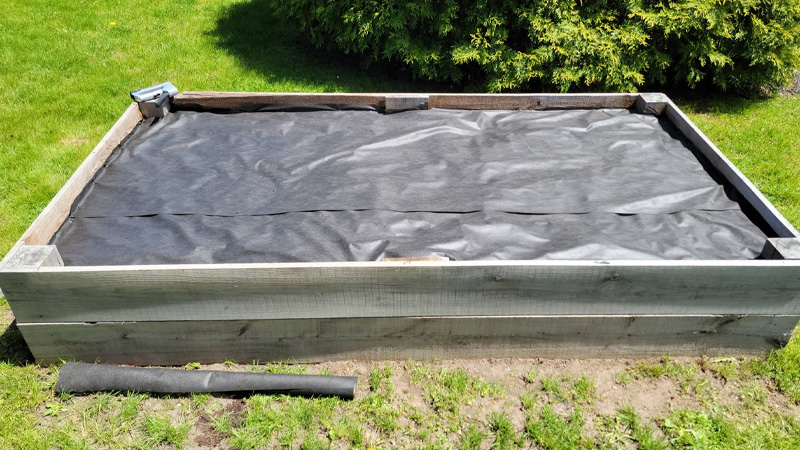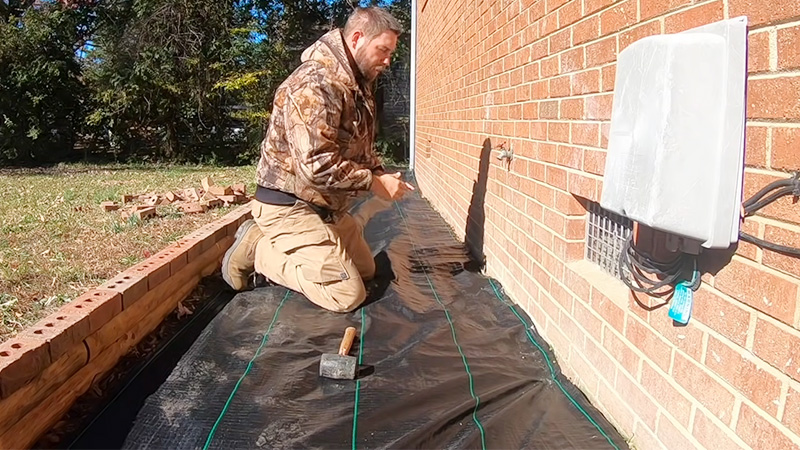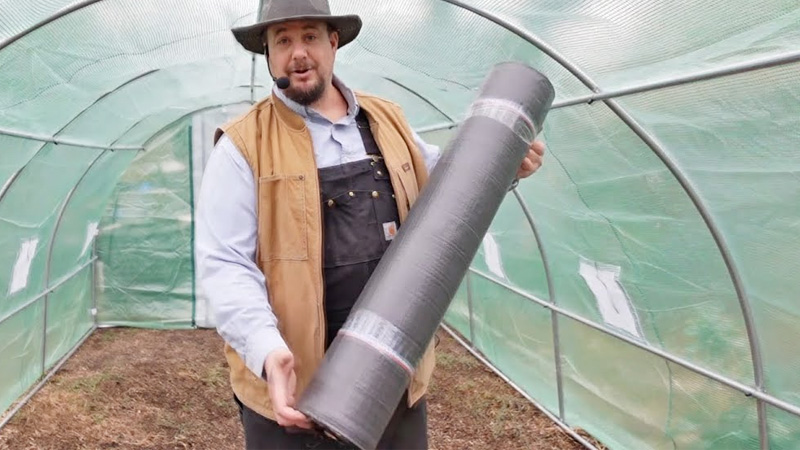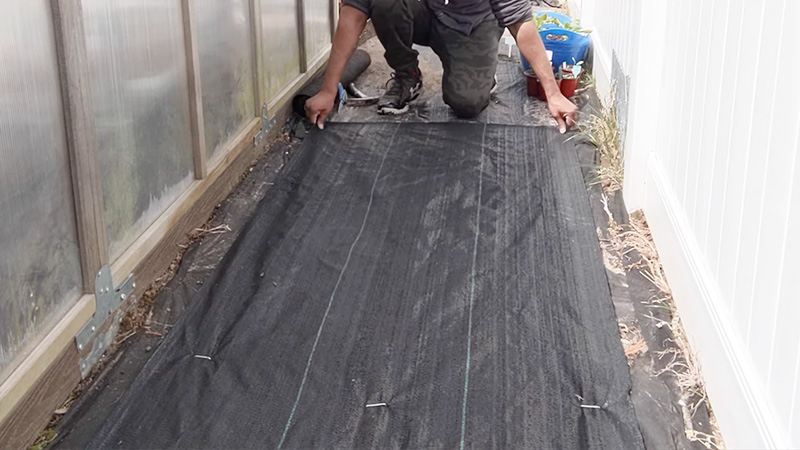When it comes to maintaining a stunning garden while minimizing weed growth and water loss, landscape fabric is a gardener’s secret weapon. Whether you’re a seasoned pro or just starting with your green thumb, this guide will walk you through the ins and outs of using landscape fabric.
Landscape fabric, also known as weed barrier or weed control fabric, is a versatile material that can make a world of difference in your landscaping efforts. It acts as a protective barrier between the soil and the elements, helping you save time and effort on garden maintenance.
In this comprehensive guide, we will cover how to use landscape fabric. We’ll also delve into the benefits of using landscape fabric, from weed suppression to improved water conservation. So, let’s dive in and transform your garden into a low-maintenance, picturesque oasis.

How to Use Landscape Fabric?
Before we dive into the how-to, let’s understand what landscape fabric is. Landscape fabric, also known as weed barrier or weed control fabric, is a synthetic material designed to inhibit weed growth while allowing air, water, and nutrients to penetrate the soil.
It comes in various thicknesses and grades, with some even featuring perforations for easy planting.
Prepare the Soil
Start by clearing the area of existing weeds, rocks, and debris. Use a rake to level the soil and create a smooth surface. Roll out the landscape fabric over the prepared area. Cut it to size, leaving a few extra inches on each side to overlap and secure.
Secure the Fabric
Use garden pins or staples to secure the fabric to the ground. Place them approximately every 12 inches along the edges and seams. Avoid leaving any gaps where weeds could sneak through.
If you plan to install plants through the fabric, cut an X-shaped slit for each plant location. Fold back the flaps and dig holes for your plants. Then, place the plants in the holes and fold the flaps back over the root balls.
Cover with Mulch or Gravel
To improve aesthetics and further inhibit weed growth, cover the fabric with a layer of mulch or gravel. This also helps anchor the fabric in place.
Water your plants as needed, taking advantage of the moisture retention benefits of the landscape fabric. Periodically check for any weeds that might poke through and remove them promptly.
Tips for Success
Overlap seams by at least 6 inches to ensure no weeds can penetrate. Don’t leave landscape fabric exposed for extended periods without mulch or gravel cover, as it can break down when exposed to sunlight.
Regularly inspect the fabric for tears or damage, and repair or replace it as necessary. When installing plants through the fabric, make sure the slits are large enough to accommodate the plant’s growth.
By following these steps and considering the right type of fabric for your needs, you can create a beautiful and manageable outdoor space that requires less time and effort to maintain.
Tools and Materials You’ll Need

Here’s a table listing the materials you’ll need for using landscape fabric in gardening and landscaping projects
| Material | Description |
| Landscape fabric | Woven or non-woven fabric designed for outdoor use. |
| Utility knife or scissors | For cutting and shaping the fabric to fit the area. |
| Garden staples or stakes | To secure the fabric in place on the ground. |
| Weed barrier pins or pegs | Optional, for extra anchoring in windy areas. |
| Shovel or garden rake | For preparing the soil before laying the fabric. |
| Mulch or decorative stone | To cover and protect the fabric, improving aesthetics and preventing weed growth. |
| Planting tools | Such as trowels or garden gloves for planting in the fabric. |
| Landscape edging | Optional, for defining the edges of the fabric and preventing growth around the borders. |
| Soil or compost | For amending the soil in planting areas. |
| Plantings | Shrubs, trees, flowers, or other desired plants. |
| Watering equipment | Hoses, watering cans, or irrigation systems for plant maintenance. |
| Gravel or sand (optional) | For use under the fabric in pathways. |
| Fertilizer (optional) | For plant nutrition if not mixed with the soil. |
How to Choose the Right Landscape Fabric?

Selecting the right landscape fabric is crucial to achieving the best results. In this guide, we’ll walk you through the key factors to consider when choosing landscape fabric and help you make an informed decision for your gardening needs.
Material Matters
Landscape fabric is primarily made of two materials: polypropylene and polyester. Each has its own set of characteristics and best-use scenarios:
Polypropylene
Polypropylene landscape fabric is generally more budget-friendly, making it a popular choice for many gardeners. It’s lighter and easier to handle than polyester fabric, which can be an advantage during installation.
Polypropylene landscape fabric offers good durability, but it may not last as long as polyester in harsh conditions or under heavy foot traffic. If you plan to change your garden layout frequently, polypropylene is a practical choice.
Polyester
Polyester landscape fabric is more durable and resistant to wear and tear, making it a better option for long-term installations. It can withstand heavier foot traffic, making it suitable for areas with regular human activity.
Polyester fabric tends to be more UV-resistant, ensuring it doesn’t break down as quickly when exposed to sunlight. It’s generally more expensive than polypropylene, but the durability may justify the investment.
Tip: Consider the longevity and specific needs of your garden. For long-term and high-traffic areas, polyester may be the better choice, while polypropylene may suffice for seasonal or less demanding applications.
Thickness and Density
Landscape fabric thickness is typically measured in ounces per square yard (oz/yd²). The thickness and density of the fabric affect its weed-blocking capabilities.
Thicker fabric (higher oz/yd²): Provides better weed control and is more durable. It’s a suitable choice for areas with persistent and aggressive weeds.
Thinner fabric (lower oz/yd²): While it may offer some weed control, it’s better for light-duty applications and temporary use.
In general, consider using thicker fabric for long-term installations and in areas where weeds are a constant challenge.
Perforations for Planting
Some landscape fabrics come with pre-cut holes or lines, making it easier to plant directly through the fabric. These perforations are particularly useful if you plan to install plants in your garden while using the fabric as a weed barrier.
When choosing perforated landscape fabric, consider the spacing and size of the perforations. Ensure they align with your planting needs and preferences.
However, keep in mind that not all planting scenarios require perforated fabric, and you can always cut your own slits or holes if needed.
UV Resistance
Exposure to sunlight can break down landscape fabric over time. To ensure the fabric’s longevity, especially in sunny climates, look for options labeled as UV-resistant. UV-resistant fabric is designed to withstand prolonged exposure to sunlight without deteriorating.
Width and Length
Landscape fabric typically comes in rolls, and the width and length of these rolls can vary. Measure your garden area accurately and choose a roll size that suits your needs.
Consider purchasing extra fabric to account for overlapping seams, especially if your garden is irregularly shaped.
Brand Reputation and Reviews
Research the reputation of landscape fabric brands and read customer reviews. The experience of other gardeners can provide valuable insights into the product’s quality, durability, and performance in real-world settings.
Budget Considerations
Lastly, consider your budget. While polyester and UV-resistant options may be more expensive, they often offer greater longevity and performance, which can ultimately save you money in the long run by reducing the need for replacement and maintenance.
Carefully assess your specific gardening needs, considering factors such as material, thickness, perforations, UV resistance, and your budget.
Installing Landscape Fabric in Special Circumstances

While landscape fabric is a valuable tool for weed control and garden maintenance in standard scenarios, there are special circumstances where you may need to take extra precautions or adapt your installation approach.
Let’s explore some of these unique situations and provide tips and techniques for installing landscape fabric effectively.
Sloped Terrain
When working on sloped terrain, landscape fabric can be prone to shifting or sliding, potentially exposing the soil and undermining its effectiveness. To address this challenge, install landscape fabric across the slope rather than along it.
This prevents water from flowing under the fabric and washing it away. Use additional garden pins or staples to secure the fabric firmly in place.
Be generous with pin placement, especially along the upper edge where water runoff can exert the most force. Consider using heavier, thicker landscape fabric for added durability on sloped surfaces.
High-Wind Areas
Gardens in windy regions can experience landscape fabric shifting or lifting, which can compromise their weed control and erosion prevention functions. To tackle this issue, choose a thicker and heavier landscape fabric to better resist wind forces.
Use a double-layer installation technique: Lay one layer of fabric, secure it with pins, and then overlay a second layer perpendicular to the first. This crisscrossing pattern helps anchor the fabric and prevents it from lifting.
Ensure the edges and seams of the fabric are well secured with garden pins to prevent wind from getting underneath.
Extreme Heat and Sunlight
Intense sunlight and high temperatures can cause landscape fabric to deteriorate and lose its effectiveness over time. To mitigate heat and sunlight-related issues, opt for landscape fabric labeled as UV-resistant.
This type of fabric is designed to withstand prolonged sun exposure without breaking down. Consider using mulch or gravel as a protective layer over the fabric.
It helps shield the fabric from direct sunlight, prolonging its lifespan. Periodically inspect the fabric for signs of wear and tear, and replace it when necessary to maintain its functionality.
High-Traffic Areas
Gardens or pathways that experience heavy foot traffic can put additional stress on landscape fabric, potentially causing it to tear or wear out more quickly. To address high-traffic areas, use a durable, heavy-duty landscape fabric such as polyester, which is more resistant to wear and tear.
Install additional garden pins or staples in high-traffic zones to secure the fabric more effectively. Consider using stepping stones or pavers in heavily traveled areas to reduce direct wear and tear on the fabric.
Rain Gardens or Waterlogged Soil
In areas with consistently wet or waterlogged soil, landscape fabric can sometimes impede water drainage and cause problems.
To handle waterlogged soil situations, use a landscape fabric with perforations that allow for water penetration. These perforations enable proper drainage while still providing weed control.
Ensure that the fabric is properly sloped to direct excess water away from your garden beds. Monitor the water drainage and adjust the fabric’s installation as needed to prevent water pooling.
FAQs
Can I reuse landscape fabric?
Yes, you can reuse landscape fabric, but it’s important to inspect it for wear and tear. If the fabric is still in good condition and hasn’t degraded significantly, you can clean it, trim any damaged areas, and reinstall it in a different area of your garden.
Should I use landscape fabric under mulch or gravel?
Yes, using landscape fabric under mulch or gravel is a common practice. It helps prevent weed growth, improves moisture retention, and keeps the mulch or gravel in place.
Can I plant through landscape fabric?
Yes, you can plant through landscape fabric. Some landscape fabrics come with pre-cut perforations or lines to make planting easier. Alternatively, you can cut slits or holes in the fabric to accommodate your plants.
Does landscape fabric work for all types of weeds?
Landscape fabric is effective at preventing many types of weeds, particularly annual and shallow-rooted weeds. However, it may be less effective against deep-rooted perennial weeds like dandelions or invasive grasses. In these cases, thorough soil preparation is essential.
How do I deal with landscape fabric in winter or snowy conditions?
During winter or snowy conditions, landscape fabric can still be effective, but it may be partially covered or hidden by snow. It’s essential to install a protective layer, such as mulch or gravel, over the fabric to prevent it from exposure to freezing temperatures.
Conclusion
By now, you’ve learned the invaluable benefits of using landscape fabric in your garden. This simple yet effective tool can help you maintain a weed-free, thriving landscape while conserving precious resources like water.
Incorporating landscape fabric into your gardening routine is a smart investment of time and effort. It not only reduces the need for constant weeding but also promotes healthier plant growth by preventing weed competition and preserving soil moisture.
Remember that proper installation is key to reaping these benefits. Take your time to prepare the soil, choose the right type of fabric, and follow our step-by-step instructions.
So, go ahead and put your newfound knowledge to use. Transform your outdoor space into a haven of beauty and ease, all thanks to the power of landscape fabric. Your garden will thank you, and you’ll have more time to savor its delights. Happy gardening!
Leave a Reply